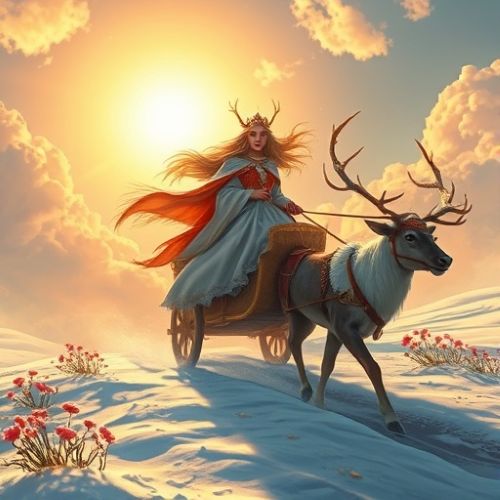Sami Mythology
Sami mythology, the spiritual tradition of the indigenous Sami people of northern Scandinavia and parts of Russia, is a deeply shamanic and animistic belief system rooted in harmony with nature. For the Sami, every element of the landscape—mountains, rivers, forests, and animals—was alive with spiritual power. These beliefs reflect the Sami’s nomadic lifestyle, which was centered on reindeer herding, fishing, and hunting, and their mythology expressed the idea that humans were part of a living, interconnected world. Unlike the pantheons of other Northern European mythologies, Sami mythology is more fluid, blending gods, nature spirits, and ancestral beings that together shaped the spiritual life of the community.
Central to Sami spirituality is the noaidi, or shaman, who acted as an intermediary between people and the unseen world. Through drumming, chanting, and trance states, the noaidi communicated with deities and spirits to heal the sick, protect communities, and ensure balance between humans and nature. Among the important deities were Horagalles, the thunder god associated with protection and strength, and Máttaráhkká, the mother goddess linked with fertility and family. The mythology also includes Radien, a high god connected with the cosmic order, and numerous spirits that inhabited specific parts of the natural world. This shamanic focus shows how Sami mythology was not only religious but also practical, guiding daily life and survival in the challenging Arctic environment.
Sami mythology also reveals a worldview where gender, family, and the cycle of life were deeply sacred. The female deities known as the daughters of Máttaráhkká had specific roles, such as helping with childbirth and protecting children, reflecting the importance of family in Sami culture. At the same time, animal spirits played a vital role, with reindeer, bears, and birds often serving as messengers or guides between worlds. The sacred drum, decorated with symbolic images of gods and spirits, was a central ritual tool, embodying the Sami belief that sound, rhythm, and imagery could connect the human and spirit realms. Through these traditions, Sami mythology carried both spiritual depth and practical wisdom, linking culture, survival, and reverence for the natural world.
Today, Sami mythology remains an essential part of Sami cultural identity and has gained recognition as a unique contribution to Northern European mythology. Although Christianization suppressed many traditional practices, stories of gods, spirits, and shamanic rituals survive in folklore, oral traditions, and revived cultural practices. Modern interest in Sami mythology highlights its themes of ecological balance, respect for nature, and spiritual connection—values that resonate strongly in contemporary discussions about sustainability and indigenous rights. By celebrating Sami mythology, we not only preserve the spiritual traditions of the Sami people but also embrace a worldview that honors nature and cultural heritage in profound ways.


